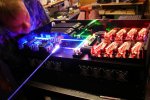Seems like if it was something inexpensive enough, efficient enough and easy enough for someone on one of our budgets to do, I am sure it would have been done before  by someone like arctos for example...
by someone like arctos for example...
But it certainly seems as though you are ambitious enough to go through with it, so post some pictures and results. I am sure others would love to see it too...
But it certainly seems as though you are ambitious enough to go through with it, so post some pictures and results. I am sure others would love to see it too...






